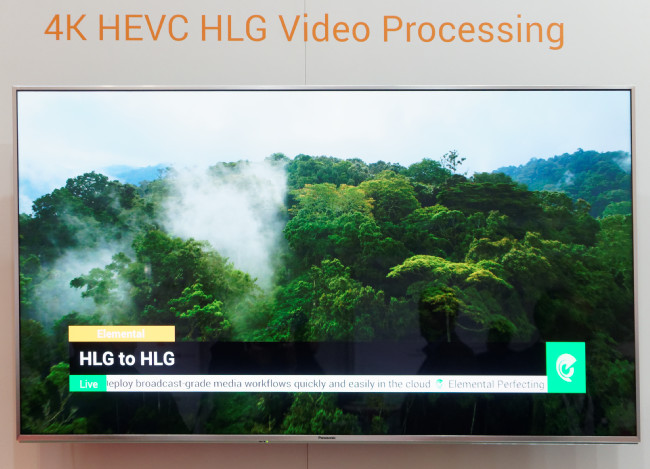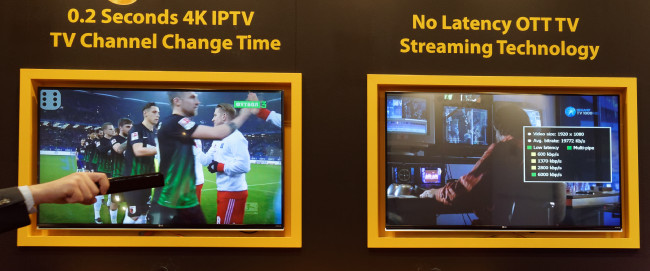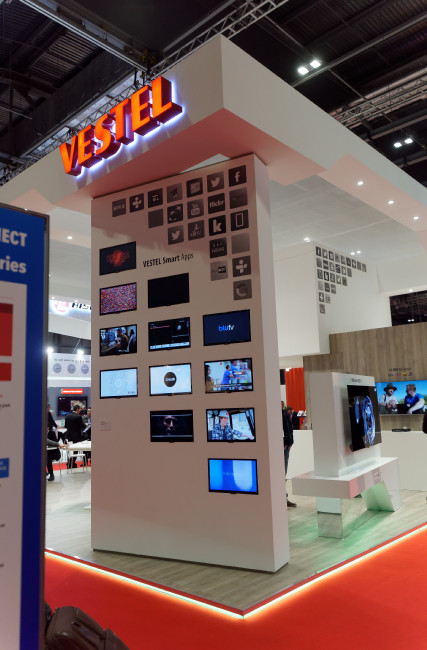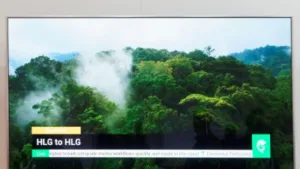Elemental is a key provider of compression and transcoding systems for broadcasters and was one of the few companies at the show that was demonstrating and taking about HDR. The firm was showing how it could render HDR content in the HLG format. It told us that the lack of metadata and backward compatibility were big plus points for their customers, so they were keen to show that however the data came into its compressors, it could send out simple and backwards compatible HLG signals. The firm told us that it’s customers really didn’t want to have to deal with anything that wasn’t extremely simple to support. However, it can also support other schemes and basically offers ‘anything in’ to ‘anything out’. Elemental showed how any HDR could be converted to HLG. Image:Meko
Elemental showed how any HDR could be converted to HLG. Image:Meko
One of the issues that has needed addressing is that, typically, the compression algorithms used for broadcast tend to rob low intensity data because, historically, this was rarely visible. However, HDR sets have made this kind of approach more visible, so there is some change in the details of compression to reduce the visibility of this kind of technique.
Huawei had, we reckon, the biggest booth, but was focusing on infrastructure and services to broadcasters and service operators.
IFeelSmart is based in Paris, France, and specialises in developing User experiences (UX) and user interfaces (UI). One of its major clients is Bouygue Telecom and the firm’s UI is used in the BBox. It is also supplying companies in the US and in Israel. In total, its interfaces are in around a million STBs, but the company has also developed apps for tablets, smartphones and browsers, to allow operators to offer a unified look and feel for TV Everywhere services. The software is typically Android-based, but can be run on Linux and most hardware and middleware suppliers can be supported.
 IFeelSmart designed this BBox Interface. Image:Meko
IFeelSmart designed this BBox Interface. Image:Meko
Infomir is from the Ukraine and provides STBs and other CPE for operators. It has been in the business for 15 years and told us that it has 865K STBs out in the market. The boxes can be based on Android or Linux operating systems and the company can support all the main chip suppliers. The firm told us that its speciality is dealing with smaller operators and offering 24/7 support to deal with any problems. It is also fast to market and can deal with (relatively) small volume roll-outs of boxes. The company has its own middleware, but can also support other platforms according to operator choice.
At the event, speaking on a panel session, Mark Giesbers of Liberty Global said that his firm is ‘not married to the idea of a set-top box’. At the moment, the STB is the best way to provide the best consumer experience at a known quality level. However, if sticks and cloud services are good enough, they could replace the STB or run alongside them. The firm told DTV Europe that it planned to roll out the Virgin TV V6 EOS box that it started to supply at the end of 2016 across all its territories in 2018, but there will be HDD and cloud-based versions.
Qarva is from Georgia and has been operating in the European TV market as a supplier of software for IPTV providers for ‘six or seven’ years. At the show, the company was showing its fast channel change technology for IPTV suppliers which certainly looked almost as fast as a traditional broadcast ‘zapper’, and is rated at 0.2 seconds. That’s a real challenge on most IPTV systems which can take up to 2 seconds to change channel. The company told us that its technology is ‘easy to integrate’ on Linux or Android-based boxes.

The company was also showing its ‘multi-pipe’ technology that can help service providers avoid excessive latency by making the IP-based broadcast pipe more reliable and dramatically reducing the need for big buffers. The company was showing an UltraHD system that was streaming UltraHD content from the US to the floor of the show. If it was doing what it said it was, the demonstration was impressive. The technology is available on the server side and Qarva can support ‘trick play’ features as well. In addition to STB-based solutions, the company has smartphone apps for ‘content everywhere’ solutions.
Sumavision is from Beijing and the company develops set top boxes and other items of ‘customer premises equipment’ (CPE). The company has depth in technology and told us it has its own DRM, EPG and CMS for supporting broadcasters and content owners. It is looking to expand its business although it is already a supplier to Vector of Poland. The firm is confident that it can meet all the technical requirements of customers in Europe. The firm told us that it is much more flexible than some larger suppliers and can also generate custom designs for (relatively) low volumes. It is also happy to fit around parts of the existing infrastucture, as it has a wide range of products and services.
Skyworth was at the show to talk to STB and other customers and told us about the gaming platform that it has developed with Tencent, but as we explained, the company told us about this at IBC, so it didn’t count as news!
TCL was at the show but told us that it had nothing new on the CPE side since IBC.
Unicoms Services of Bulgaria launched an end-to-end hosted OTT service for PayTV operators that want to add OTT services. It is working with Conax and AppearTV to build the services. The “white label” version can be re-branded for operators, or the company will work on a revenue share basis.
Vestel was at the show, but told us that it had no new STBs since IBC. I have to say that I wasn’t convinced, it seems more likely that the firm was simply having one of its ‘we don’t want to talk to the press’ moments, which it has from time to time. The firm had a number of TVs including the 65″ OLED that it has shown several times as well as hospitality TVs and Android-based systems. There were the usual interactive 65″ displays and digital signage, as well.


